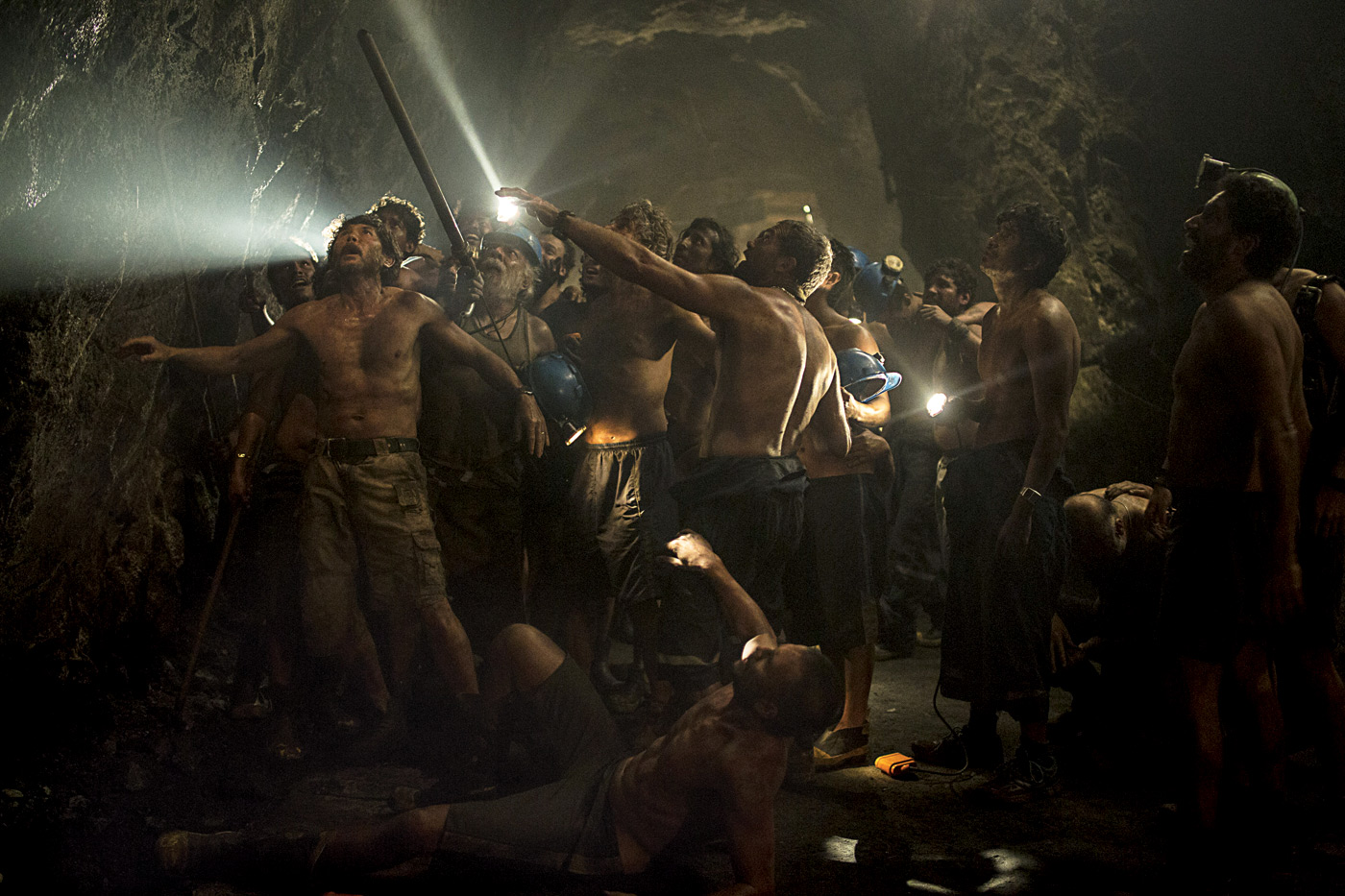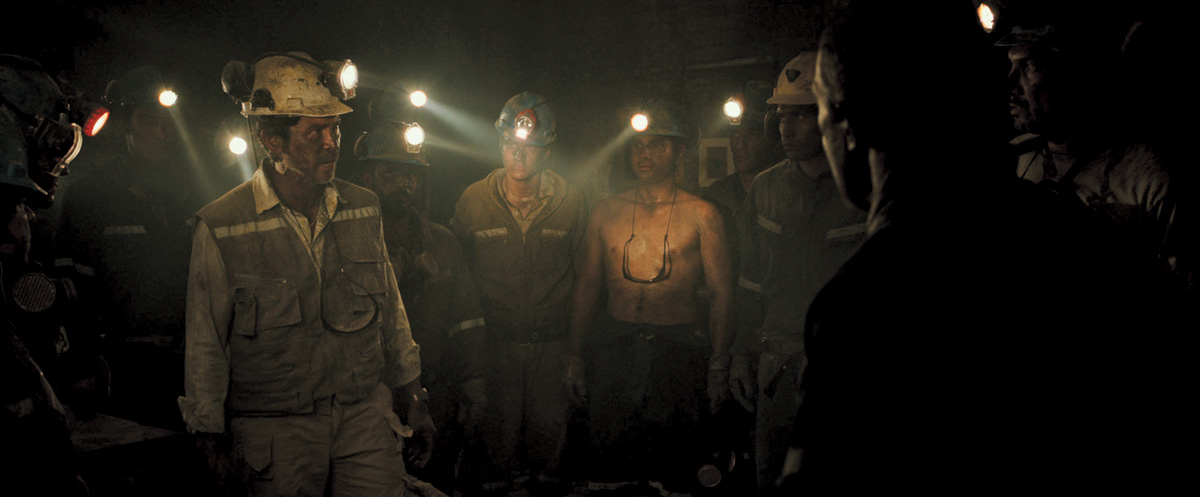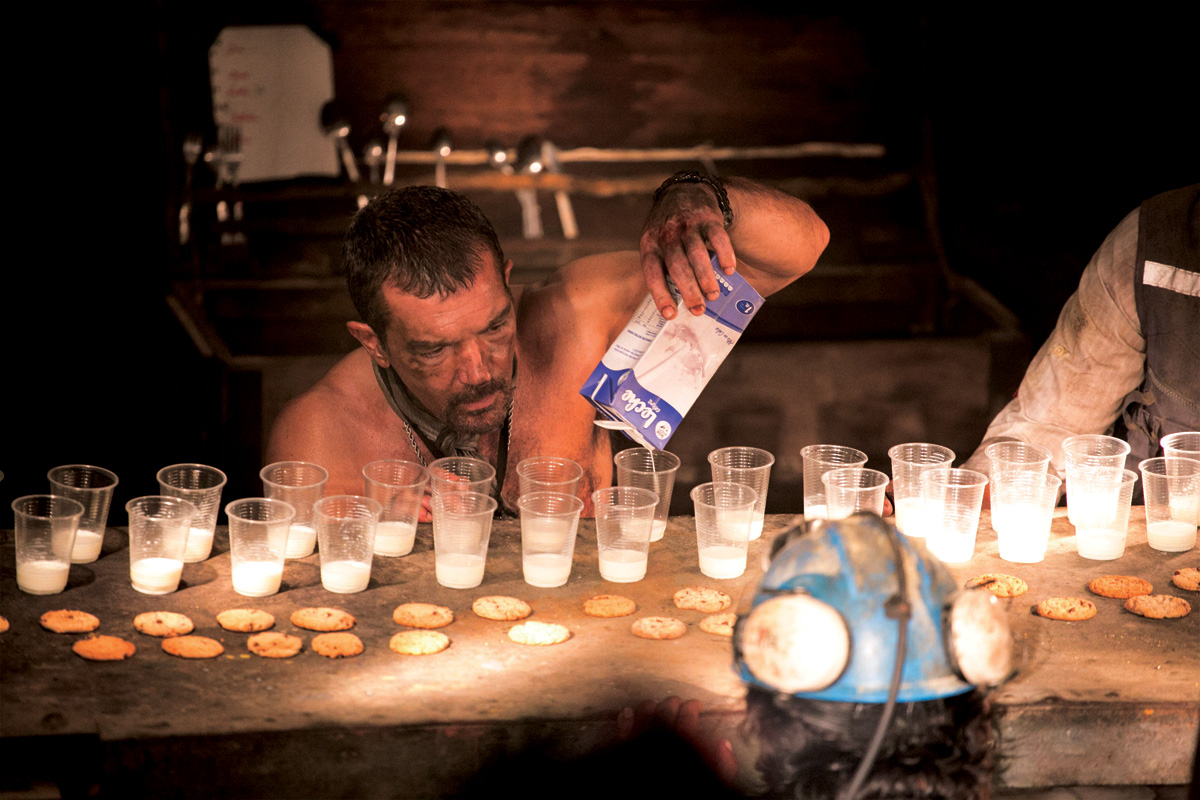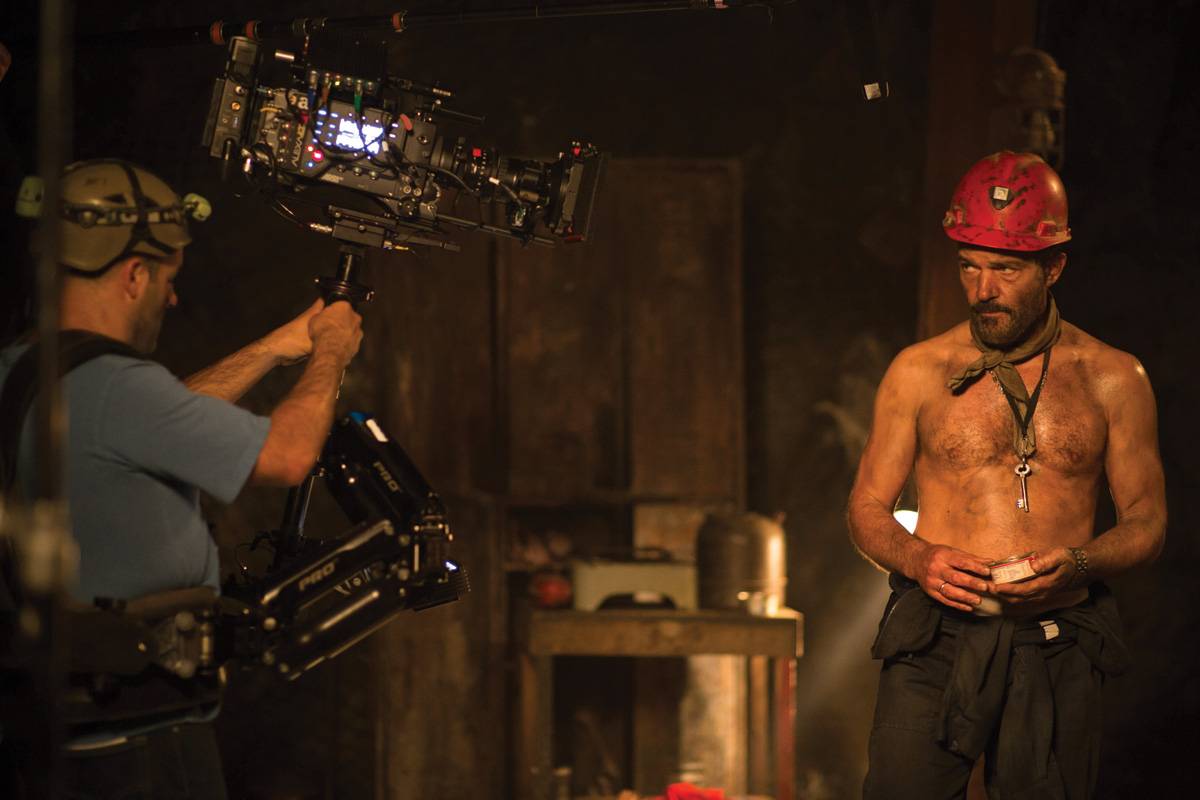Checco Varese, ASC, redefines chiaroscuro in one of the planet’s most harsh environments
Imagine a place where the most basic elements of human life – light, food, water, going to the bathroom (!) – become complex logistical challenges of the highest magnitude. Then imagine bringing hundreds of filmmakers, actors, equipment, and resources into that deep, dark world and trying to make a Hollywood movie. That’s exactly what Guild cinematographer Francesco “Checco” Varese, ASC, and director Patricia Riggen tunneled into with Warner Bros.’ upcoming drama, The 33, shooting inside two real mines outside Bogota, Colombia, to faithfully translate the collapse of the Copiapó gold and copper mine in Chile five years ago, which trapped dozens of miners 2,300 feet underground for a mind-boggling 69 days. In the most pleasing of cinematic ironies, a story from one of the darkest places on earth comes to the screen laced with light (to symbolize hope) throughout.
It was in August 2010 that events in the remote Atacama Desert captivated a billion people across the globe (on live TV). The collapse of the privately owned San José mine, 120 years old and littered with a history of safety accidents and violations, came just six months after Chile’s devastating earthquake and tsunami; conventional wisdom dictated no survivors. But when, after 17 days, a note taped to a drill bit that had penetrated “the refuge,” where the men had gathered, announced all 33 were alive, rescue efforts, led by the Chilean government and aided by three international drilling teams and a dozen multi-national corporations, shifted into high gear.
Thanks to Riggen and Varese’s creativity in absurdly demanding conditions, we live and breathe each moment with the men below ground (led by Antonio Banderas, Lou Diamond Phillips, and Juan Pablo Raba) and their loved ones and rescuers on the surface (Juliette Binoche, Cote de Pablo, Gabriel Byrne and Rodrigo Santoro among them). The characters all ride the same roller coaster – fear, despair, hope, boredom, and, finally, intense joy – that the real miners and their families experienced. Their miraculous survival was almost too implausible, even by Hollywood standards, and yet, Varese says the only way to sell the story’s unbelievable twists and turns was to make the on-screen product as real as humanly possible.
“You can’t build a mine, or even one-hundred yards of tunnel to simulate a mine, when what’s needed is two-and-a-half miles of the real thing,” Varese recounts from his L.A.-area home. “Chile has a lot of earthquakes, so no company will bond a film crew; it also has a thriving mining industry, so there’s no way we could close a real mine for eight weeks.”
Varese, who is Peruvian-Italian and shot news for many years around the world, says he remembered a 500-year-old salt mine in Colombia called Zipaquirá that was stable (as far as mines go). “We decided everything underground would be there, and in another, smaller mine nearby called Nemocón,” he continues. “Everything above ground would be shot in the Atacama Desert, just 10 kilometers from the mouth of the real San José mine.
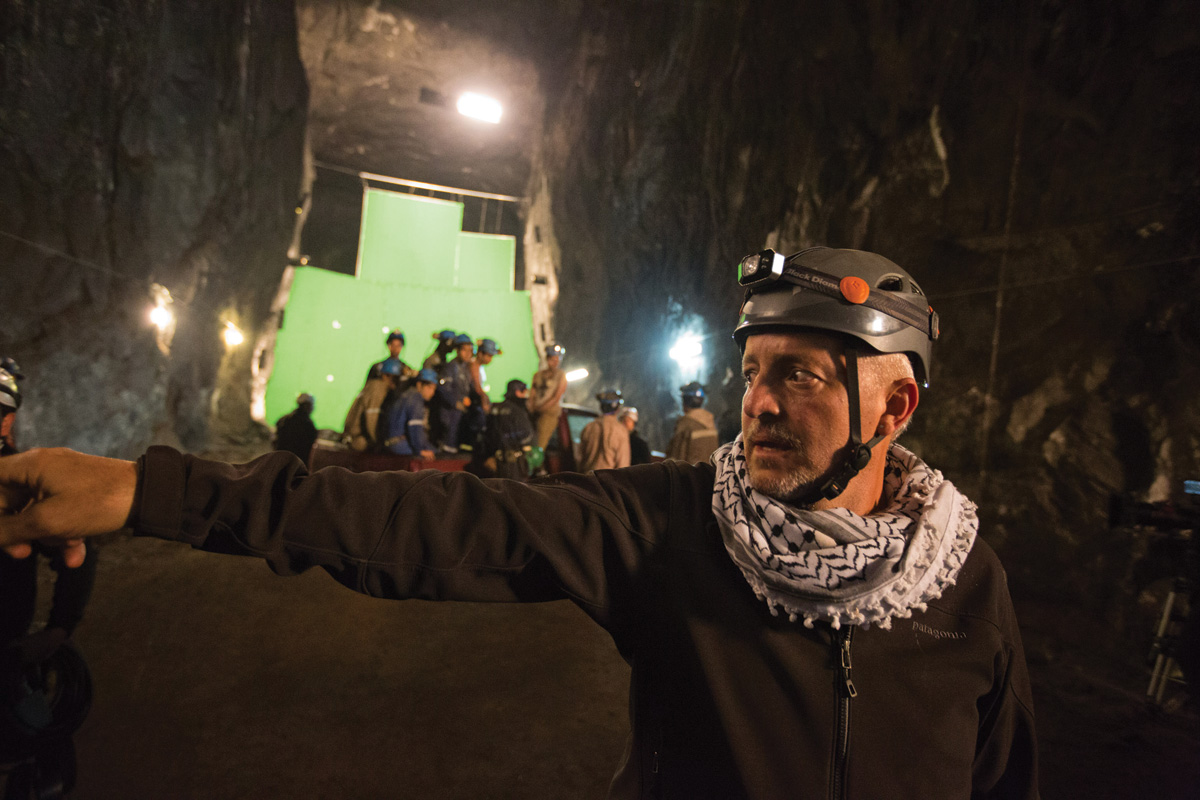
“Mines are not places where people are supposed to be, because they collapse, all the time,” Varese adds with a wry smile. “And miners don’t need much light to do their work – they dynamite some holes, and then drive the dirt to the surface. That meant we basically had to recreate a non-existent mine inside a real one, and bring everything down.”
Working with gaffer David Lee, Varese devised a lighting plan built in four sections.
“The first stage was the working mine before the collapse,” he explains. “If a real mine has ten lights we would have 60. We could not bring in generators because it would destroy the air quality, so David had a big challenge bringing in power.”
For Zipaquirá, Lee pulled power from a high-voltage substation inside the mine. “That meant we were using [often] unreliable local power, and new transformers had to be installed to get us a more workable 440 volts, and we still had to cable 1.5 miles of tunnels,” Lee recalls. “For Nemocón, we used a standard show generator outside the mine’s entrance running at 440 volts, and cabled into the mine – about one-quarter of a mile.”
“The number of battery-operated work lights required were slow in arriving, and existing power in the mine was limited,” he continues. “So everything was installed in almost complete darkness. Our phenomenal local crew basically ran thousands of feet of cable with flashlights and extension ladders over the course of many weeks.”
And that’s not all. Food had to be eaten in specially prepared enclosures, lest the fine silicate get into the filmmakers’ bloodstreams. Varese remembers a day in video village with Riggen where the safety coordinator (a real miner) asked them to stop shooting and get up. “He walks over with a huge piece of rebar and pokes at a little crack above where we were sitting,” Varese recounts, “and this massive piece of stone falls down. He nods and says, ‘It didn’t look right.’”
The second stage of lighting includes the most impressive set piece in the film – the mine’s collapse. Recreated in two days and 280 setups, the collapse was low-fi and gritty, with a minimum of CGI. For example, as the miners race through the tunnel in utter panic, garbage bags filled with fake rocks and debris were hung over the actor’s heads and triggered to collapse. (The bags were later painted out in post.)
Argentinian Steadicam pro (and Local 600 member) Matías Mesa led A-camera operation for the collapse (and all of the subsequent scenes inside the mine). Mesa’s lead ALEXA coverage was built upon one theme: How would it look to a news camera operator covering the real event?
“When I sat down with Varese to design the collapse,” Riggen shares, “I had already met with the other departments and knew we had a few specific pieces that had to be choreographed – debris falling, green screen for VFX, cable rigging for the megastone falling, et cetera. But I knew the bulk of the collapse had to look real. Actors running in a real mine, vehicles rushing through the darkness, chaos, fear, confusion, with Matías and the other cameras running with them.”
The third and perhaps most important stage of The 33’s lighting scheme occurs when the men hunker down in and around the refuge, waiting to be rescued. Their de facto leader, Mario Sepulveda (Banderas), becomes the glue that pulls them away from desperate, self-motivated measures (like cannibalism). Since the collapse took out all power, save for a handful of bulbs juiced up by vehicle batteries, the main source of light was the miners’ headlamps, which Varese describes as both blessing and curse.
“We shot this movie in 2013, after all of the headlamps became LED,” he recalls. “Consumer LEDs, of course, are ugly lights, with a short peak on red or blue for daylight, and no way to grab another color and make it softer in the eyes. In 2010, when the mine collapsed, all of the headlamps were tungsten. And since Patricia wanted to be period-correct, we had to locate 100 tungsten lamps – 33 for each miner, 33 more because we always needed to be charging a spare unit, and 33 more for second unit.”
Lee configured five headlamps with dimmers that he controlled via iPad, but that approach became too limiting for the actors. The ultimate solution was to use those actors off screen as human lighting elements, positioned as key, fill, shadow fill, etc. as needed for each scene.
“Checco choreographed each [off-stage] actor so that they knew when to turn with the actor on-screen so the light would hit him, say, in the chest and not the face,” Riggen marvels. “Lou Diamond Phillips, Antonio Banderas, Juan Pablo Raba all had cues from Checco to light each other, which I don’t think has ever been done before.”
“Essentially they all became my gaffers,” Varese laughs. “I worked with them for hours as to how and where to point their headlamps, how to avoid the camera, where the shadows were on Antonio’s face, etc. It was absolutely crazy, but quite effective.”
The bulk of the refuge scenes were shot in Nemocón, which Riggen describes as “more feminine” than the large and dangerous Zipaquirá. “It has beautiful stalactites and rock formations, but a much smaller opening,” she describes. “That means that everything we brought down, including a 15-foot Technocrane,” Varese adds, “had to be disassembled. We could not set any dolly tracks because there are no flat spots in this mine.”
As the men begin to run out of food and energy, the handful of lamps they have taken from vehicles (in reality three, in the movie 12, all controlled by Lee on dimmers) diminish. “The light is warm and enveloping as their friendship deepens,” Varese explains. “Until the moment when we see them all lie down to die, in effect, surrendering together, and it dims to darkness.”
Lee says even these car headlights (used as practicals) proved complicated. “We had to choose from a pile of old and new spare parts,” he relates. “The failure rate was high, and once you lost a piece of gear, you had basically lost it for the show unless you could repair it yourself!”
Varese’s inspiration for this section was the 17th Century Italian painter Caravaggio, whose dramatic use of naturalism was based on an extreme use of chiaroscuro. The DP hung images from a Caravaggio art book inside Nemocón, references that helped his (Local 600) DIT, Carmen Del Toro, whom Varese calls “a true artist and painter.” And a trooper, too – Del Toro absorbed all of the DP’s directives on color management deep down in the mines, reviewing shots on her Sony BVM OLED monitor with Varese, and then (using Pomfort Live Grade color-grading tool) generating CDL values the lab used for dailies.
“I am the DP’s extra set of eyes,” Del Toro explains. “I must become accustomed to his style and forecast his needs. Working inside a mine for 12 hours a day is an exercise in perseverance and patience, and there are very few people who can convince me to go to the depths of the earth with them and tell me to stay put,” she laughs about her easy-going give-and-take with Varese.
The epitome of the Caravaggio references can be seen in a haunting moment, when Sepulveda, confronted with the very last can of tuna fish, organizes a “Last Supper.” We see each of the main miners in the film absorbed in various hallucinations (including a real dairy cow that had to be walked into the mine for several weeks to acclimate to the darkness).
Riggen says the deep blacks within Nemocón brought beauty to the miners’ faces. “Caravaggio taught us not to be afraid of the dark,” she says, echoing her cinematographer (who is also her husband). “Compelling faces; naked torsos; bearded, hungry men; strong primary colors; it’s all in those paintings, and Checco made our world fit that one like a glove. The light changes when the dreams of their loved ones bringing trays of food arrive. More than anything, this moment becomes a feast of light.”
After the final dreamlike imagery passes, and the food is gone, the men lie down in the darkness to die. Then, inexplicably, a drop of water falls on Sepulveda’s cheek, signaling the drill from above has penetrated the refuge; and the lighting will soon shift into yet another phase.
“The real drill bit was six inches, so the only light they could send down was a fluorescent tube,” Varese explains, “and that’s what we used to be historically correct. Of course, they sent the most ugly one down there, like, from a warehouse – green and harsh!”
The industrial fluorescents hint at the division yet to come, when the men accuse Sepulveda of betrayal for having negotiated his own book deal [after having been in the mine for more than a month with the world watching via video conference]. Varese used a similar approach when a capsule, built for one, is sent down to rescue all 33 men. “Patricia kept saying: this needs to be real, it should not feel like a movie,” he recounts. “And, in fact, there’s not a single slow-motion shot in the movie, which would have been an obvious cinematic device for the climax.”
Riggen emphasizes how the film’s miraculous ending was watched by more than a billion people. “More than any other [scene], this moment had to be recreated with the utmost accuracy,” she insists. “Fortunately, we had many references, as every moment of the rescue is still on the Internet – on YouTube and on news websites. One of the most iconic moments is Mario Sepulveda’s coming out and yelling “Chi-chi-chi-le-le-le!” We decided to shoot it from the same ‘backward’ camera angle as the real one, and it all worked!”
For as dark and challenging as The 33’s underground is, the Atacama Desert is one of the brightest places in the world. In January, during Chile’s summer, a burning sun rises at 6:30 a.m. and does not abate until some 12 hours later – a nightmarish situation for any DP. The story above ground also required a valley where Varese’s cameras could shoot from on high to chart what would become a small city, with a hospital, school, administrative buildings and some 2,500 people camped out in tents. The location also had to run east and west to provide for some lighting variation.
“How do you build a base camp 800 kilometers north of Santiago in the middle of the desert for this huge Hollywood film company?” Varese asks rhetorically. “The answer was to build a town out of [shipping] containers – wardrobe, production, the stars’ trailers, et cetera. Another challenge was shooting in story order, to see Camp Hope grow. We buried several containers in the sand with generators inside that I knew I would have to use later in the film.”
Guild member Roberto Contreras, a Chilean who has worked around the world, most notably on the James Bond franchise, was Varese’s operator in Chile, and he worked almost entirely handheld. Riggen says that while “inside the mine, time has completely stopped for the men,” requiring a more static approach to the camerawork, “time is ticking away like crazy on the surface,” and the action needed to reflect that urgency.
Varese shot with ALEXA RAW throughout, mainly, he says, “to reach as deep into the darkness as I could inside the mine.” His go-to lenses were Angénieux zooms – 24-290 mm, 70-280 mm, 28-76 mm and 15-40 mm, as well as a full set of Cooke S4/I primes.
“The zooms were crucial for the outside portion when all of the news crews are covering the collapse,” he explains. “Inside the mine, [using zooms] was a practical issue as you didn’t want to change your lens too much because of all the dust and dirt.”
Yet another technical challenge was posed by the two distant locations. After a video camera is sent down to the miners, they communicate with their loved ones on the surface in a Skype-like give-and-take. “The miners, whom we shot in Colombia, would only be in Chile, where the family members are, for the moment we shot the extractions [individually in a capsule from the mine],” Varese begins. “So we designed a set that looks like the back of the mine with a video camera, TV and projector, and then put a video camera, TV and projector in the container in Chile. One Alexa in each location, with Patricia sitting in a tent between them with eight monitors in the Atacama Desert!”
“I wanted each miner to see his loved one on the other side of the screen, for the first time, and let the emotions flow,” Riggen explains. “Many of these scenes were improvised. You can’t achieve this unless you have both actors working together. So creating a closed-circuit system that would allow us to do this was a priority.”
The challenge with that approach, as Varese notes, “is the eyelines are always off, just like in a Skype conversation where people don’t look directly at the computer’s camera. We would have these very emotional moments where the actors are not looking at each other, and ended up putting tiny dots in the screen for where the actors had to look and then erasing them in post.”
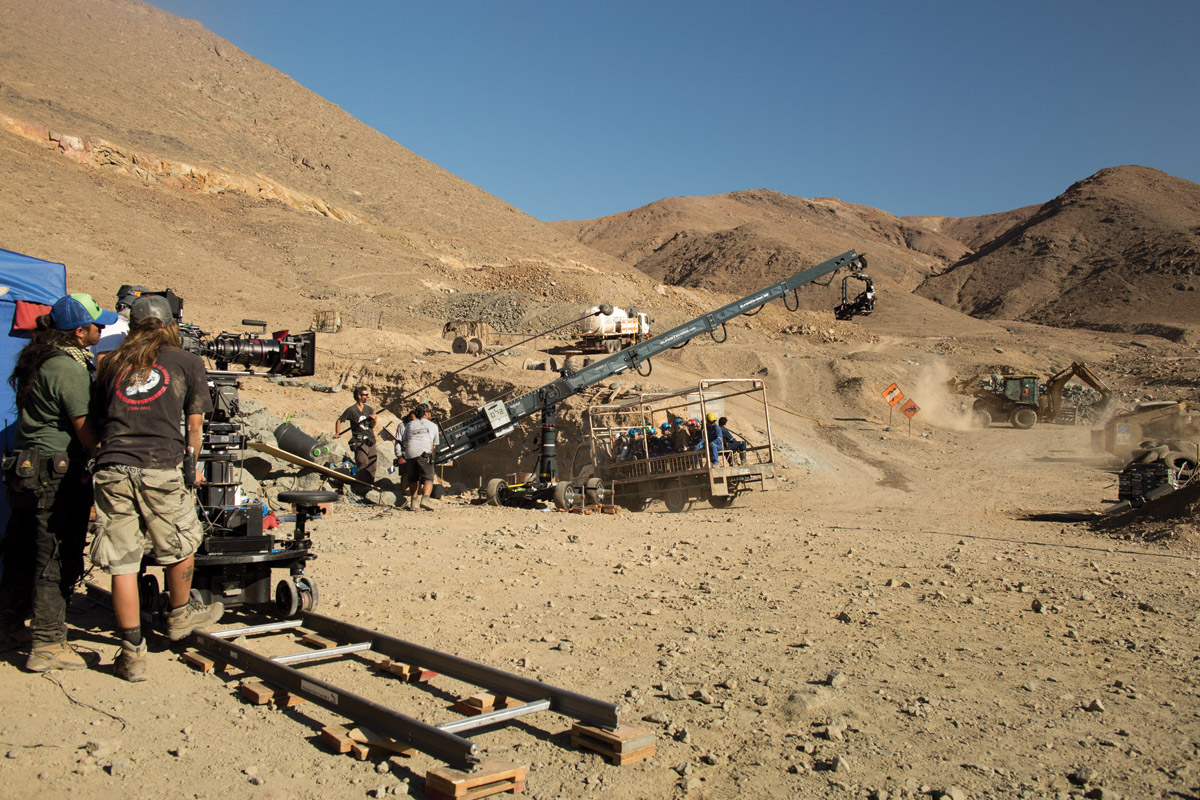
Films like The 33, based on people who are alive and still present in the world, have a choice to make (think Schindler’s List) for the end-credit roll. In this case, Riggen chose to have her DP shoot evocative black-and-white portraits of each of the 33 men on a beach in Chile at Magic Hour, for what becomes a tender and beautiful coda.
“We had to do it on Sunday as it was not budgeted into the schedule,” Varese reflects. “It was two camera assistants, myself and Carmen [Del Toro], with no lighting. It’s the only higher-frame-rate footage [48 fps] we shot, and I drew back to my music video days. Flares right into the lens, swing-and-tilt moving angles of the men, with some overexposure. We shot in color, even though we knew it would appear on screen in black and white.”
The huge seafood feast on the beach Riggen arranged (with the help of a local restaurant, and some props and art department members) caught the miners completely by surprise; the obvious joy and brotherhood they relive in this loose, free-flowing footage is completely real.
“This was, by far, the most challenging and important project of my career,” Varese concludes. “Just to screen it for the real miners was the most amazing, fulfilling experience, as they all came out crying and hugging. I’m also very proud we did it in a truthful way – the beauty in this film comes from that honesty and realism. Nothing is better than that.”
by David Geffner / photos courtesy of Douglas Kirkland and Beatrice Aguirre Zuniga/ Warner Bros.

